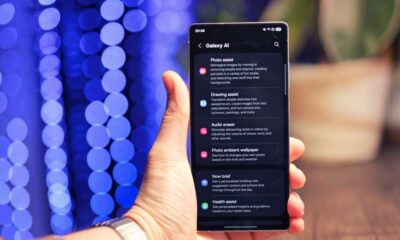AI
David vs. Goliath: Samsung’s AI Triumphs Over Giant LLMs

Samsung AI researcher recently unveiled a groundbreaking paper detailing how a compact network can outperform massive Large Language Models (LLMs) in intricate reasoning tasks.
In the competitive realm of AI development, the common belief has been that “bigger is better.” Major tech companies have invested substantial resources in creating increasingly larger models. However, Alexia Jolicoeur-Martineau from Samsung SAIL Montréal proposes a different, more effective approach with the Tiny Recursive Model (TRM).
With just 7 million parameters, a fraction of the size of leading LLMs, TRM has achieved remarkable results on challenging benchmarks like the ARC-AGI intelligence test. This challenges the notion that sheer size is the sole path to enhancing AI model capabilities, offering a more sustainable and efficient alternative.
The Limitations of Scale:
While LLMs excel at generating human-like text, their ability to handle complex, multi-step reasoning can be fragile. A single error early in the process can derail the entire solution since they generate answers token-by-token.
To address this, techniques like Chain-of-Thought have been developed, but they are computationally intensive and may still produce flawed logic. LLMs struggle with puzzles that require flawless logical execution.
Samsung’s Innovation:
Building on the Hierarchical Reasoning Model (HRM), Samsung introduces TRM, which uses a single, small network to iteratively refine its reasoning and answers. The model processes the question, an initial answer guess, and a latent reasoning feature to progressively correct mistakes in a highly efficient manner.
Interestingly, the research found that a two-layer TRM network outperformed a four-layer version, preventing overfitting on specialized datasets. TRM simplifies the complex mathematical justifications of HRM by back-propagating through its recursion process, leading to significant performance improvements.
Samsung’s Achievements:
TRM has achieved impressive results on various benchmarks, including a significant increase in accuracy on the Sudoku-Extreme dataset and Maze-Hard task compared to HRM. Most notably, TRM excels on the ARC-AGI benchmark, outperforming HRM and even surpassing many large LLMs in accuracy.
The training process for TRM has also been optimized with the introduction of an adaptive mechanism called ACT, enhancing efficiency without compromising generalization.
Conclusion:
Samsung’s research presents a compelling case against the trend of expanding AI models endlessly. By developing architectures that can iteratively reason and self-correct, it is possible to solve complex problems with minimal computational resources.
For more insights on AI and big data from industry experts, consider attending the AI & Big Data Expo. This event is part of TechEx and features leading technology events such as the Cyber Security Expo.
AI News is powered by TechForge Media. Explore upcoming enterprise technology events and webinars for more valuable insights.
—
SEO Keywords: Samsung AI researcher, Large Language Models (LLMs), Tiny Recursive Model (TRM), ARC-AGI intelligence test, reasoning tasks, Hierarchical Reasoning Model (HRM), computational resources, AI & Big Data Expo, TechEx, Cyber Security Expo, TechForge Media.
-

 Video Games2 days ago
Video Games2 days agoTekken 8: Rise of the Shadows
-

 Video Games1 day ago
Video Games1 day agoGoku Takes on the Dragon Ball FighterZ Arena
-

 Amazon2 days ago
Amazon2 days agoNeil Young Takes a Stand: Pulling Music from Amazon in Protest of Jeff Bezos’ Support for Trump
-

 Tech News2 days ago
Tech News2 days agoSamsung Galaxy UI 8: Embracing the Big Free AI Upgrade
-

 Security2 days ago
Security2 days agoCritical Vulnerability Exposed: Oracle EBS Targeted in Recent Cyber Attacks by Cl0p Hackers
-

 Apple2 days ago
Apple2 days agoExploring the Dystopian Realms of Pluribus: An Apple Original Series Trailer
-

 Microsoft2 days ago
Microsoft2 days agoEnhanced Copilot Features: Creating Office Documents and Gmail Integration
-

 AI1 day ago
AI1 day agoOracle’s Next-Gen Enterprise AI Services Powered by NVIDIA’s Cutting-Edge GPUs
























